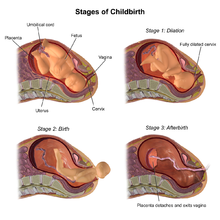
Back المخاض المطول Arabic বিলম্বিত প্রসব Bengali/Bangla Part prolongat Catalan 지연 분만 Korean 滯產 Chinese
| Prolonged labor | |
|---|---|
| Other names | Failure to progress |
 | |
| Normal stages of childbirth | |
Prolonged labor is the inability of a woman to proceed with childbirth upon going into labor.[1] Prolonged labor typically lasts over 20 hours for first time mothers, and over 14 hours for women that have already had children.[1] Failure to progress can take place during two different phases; the latent phase and active phase of labor.[1] The latent phase of labor can be emotionally tiring and cause fatigue, but it typically does not result in further problems.[1] The active phase of labor, on the other hand, if prolonged, can result in long term complications.[1]
It is important that the vital signs of the woman and fetus are being monitored so preventive measures can be taken if prolonged labor begins. Women experiencing prolonged labor should be under supervision of a surgically equipped doctor. Prolonged labor is determined based on the information that is being collected regarding the strength and time between contractions. Medical teams track this data using intrauterine pressure catheter placement (IUPC) and continuous electronic fetal monitoring (EFM).[2] IUPC is a straw that is inserted into the womb with a monitor that reads when contractions are coming and how strong they are.[2] EFMs are used to track the fetal heart rate.[2] If either devices indicate that vital signs are off and prolonged labor is beginning, it is important that the medical team begin discussing treatment and alternative options for delivery.
Prolonged labor can result from a variety of different issues, such as fetal malpresentation, issues with uterine contractions, cervical dystocia or stenosis, and cephalopelvic disproportion. Both fetal malpresentation and cervical dystocia may result in obstructed labor.[3] The cause of prolonged labor will determine the medical intervention that needs to take place. Medical professionals can either engage in preventive measures or turn to surgical methods of removing the fetus. If not handled properly or immediately treated, both the woman and the fetus can suffer a variety of long term complications, the most serious of which is death.[4] There is no "quick fix" to prolonged labor, but there are preventive measures that can be taken, such as oxytocin infusions.[4] In order to properly and safely deliver the baby, doctors will often intervene in child birth and conduct assisted vaginal delivery through the use of forceps or a vacuum extractor, or perform a Caesarean section.[5]
- ^ a b c d e "Prolonged Labor: Failure to Progress - Causes and Solutions". American Pregnancy Association. 2014-08-15. Retrieved 2018-12-07.
- ^ a b c "Prolonged Labor: Causes and Treatment". WebMD. Retrieved 2018-12-07.
- ^ Education material for teachers of midwifery : midwifery education modules. Geneva [Switzerland]: World Health Organization. 2008. pp. 17–36. ISBN 9789241546669.
- ^ a b Gallagher, John T.; Jackson, Reginald J. A.; O'Driscoll, Kieran (1969-05-24). "Prevention of Prolonged Labour". Br Med J. 2 (5655): 477–480. doi:10.1136/bmj.2.5655.477. ISSN 1468-5833. PMC 1983378. PMID 5771578.
- ^ "Procedures That May Take Place During Labor and Delivery". pennmedicine.adam.com. Retrieved 2018-12-08.